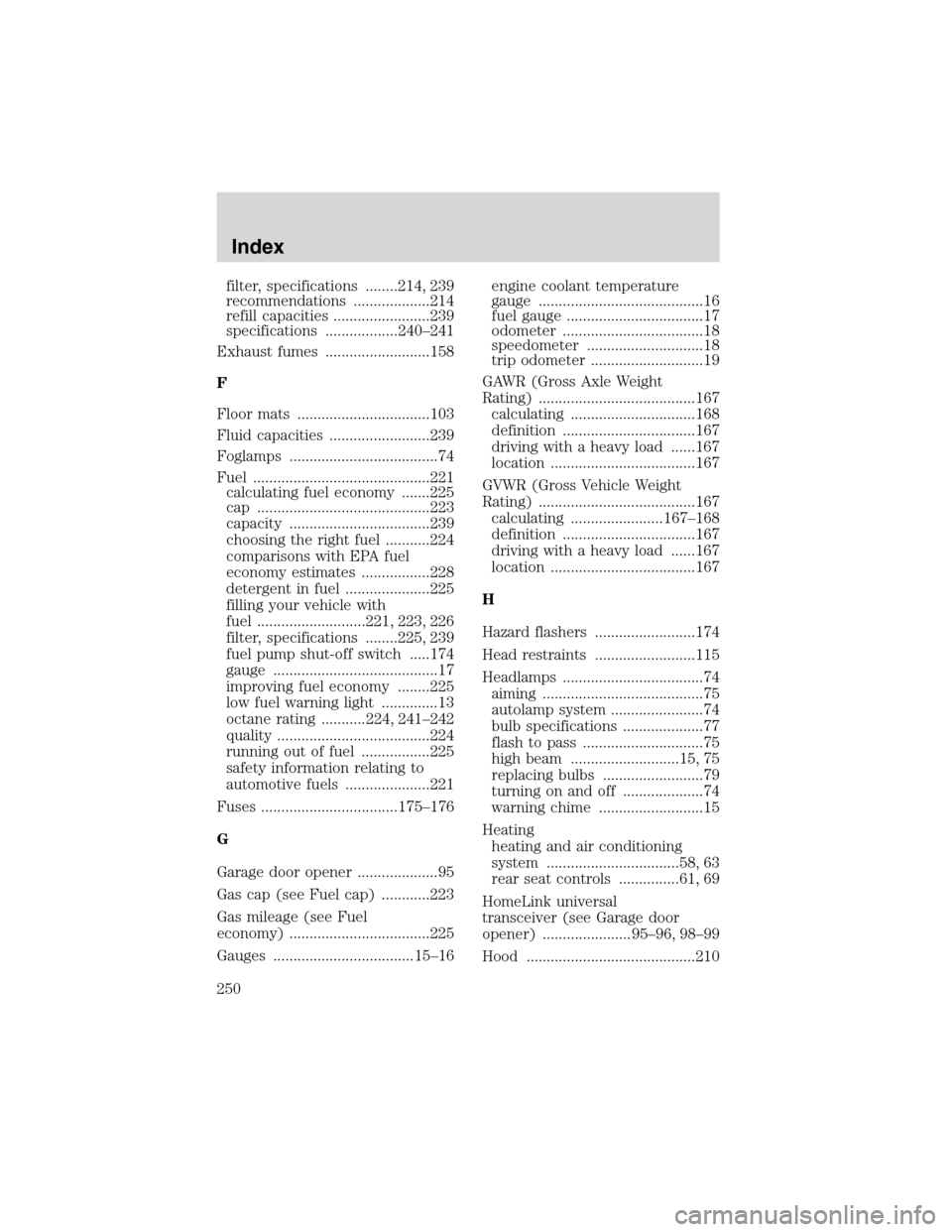open hood Mercury Villager 2002 Owner's Manuals
[x] Cancel search | Manufacturer: MERCURY, Model Year: 2002, Model line: Villager, Model: Mercury Villager 2002Pages: 256, PDF Size: 1.91 MB
Page 60 of 256

•To reduce humidity buildup inside the vehicle in warm weather
conditions, don’t drive with the climate control system in the OFF
position.
•Under normal weather conditions, your vehicle’s climate control
system should be left in any position other than the MAX A/C or OFF
when the vehicle is parked. This allows the vehicle to“breathe”
through the outside air inlet duct.
•Under snowy or dirty weather conditions, your vehicle’s climate
control system should be left in the OFF position when the vehicle is
parked. This allows the climate control system to be free from
contamination of outside pollutants.
•If your vehicle has been parked with the windows closed during warm
weather conditions, the air conditioner will perform more efficiently in
cooling the vehicle if driven for two or three minutes with the
windows open. This will force most of the hot, stale air out of the
vehicle. Once the vehicle has been“aired out”, operate the climate
control system as desired.
•Do not put objects under the front seat which may interfere with the
airflow to the rear seats (if equipped).
•Remove any snow, ice or leaves from the air intake area (at the
bottom of the windshield and underneath the hood).
•Do not place objects over the defroster outlets. These objects can
block airflow and reduce visibility through your windshield. Avoid
placing small objects on top of the instrument panel. These objects
may fall down into the defroster outlets and block airflow, in addition
to, damaging the climate control system.
To aid in side window defogging/demisting in cold weather conditions:
1. Select the position that distributes air through the Panel and Floor.
2. Set the temperature control to full heat.
3. Set the fan speed to full fan.
4. Direct the outer panel vents towards the side windows.
5. To increase airflow to the outer panel vents, close the central panel
vents.
Do not place objects on top of the instrument panel as these
objects may become projectiles in a collision or sudden stop.
Climate Controls
60
Page 79 of 256

Replacing headlamp bulbs
To remove the headlamp bulb:
1. Make sure headlamp switch is in OFF position, then open the hood.
2. Disconnect the electrical
connector from the bulb by pulling
rearward.
3. Remove the bulb retaining ring by
rotating it counterclockwise (when
viewed from the rear) to free it
from the bulb socket, and slide the
ring off the plastic base. Keep the
ring to retain the new bulb.
4. Without turning, remove the old
bulb from its socket by gently
pulling it straight back out of the
lamp assembly.
To install the new bulb:
Handle a halogen headlamp bulb carefully and keep out of
children’s reach. Grasp the bulb only by its plastic base and do
not touch the glass. The oil from your hand could cause the bulb to
break the next time the headlamps are operated.
Lights
79
Page 210 of 256

OPENING THE HOOD
1. Inside the vehicle, pull the hood
release handle located under the
bottom left corner of the instrument
panel.
2. Go to the front of the vehicle and release the auxiliary latch that is
located under the front center of the hood.
3. Lift the hood and secure it with the prop rod.
Maintenance and Specifications
210
Page 213 of 256

2. Turn the engine off and wait a few minutes for the oil to drain into the
oil pan.
3. Set the parking brake and ensure the gearshift is securely latched in P.
4. Open the hood. Protect yourself from engine heat.
5. Locate and carefully remove the
engine oil indicator (dipstick).
6. Wipe the indicator clean. Insert the indicator fully, then remove it
again.
•If the oil level isbetween the L and H marks,the oil level is
acceptable.DO NOT ADD OIL.
•If the oil level is below the L
mark, add enough oil to raise the
level within the L and H range.
•Oil levels above the H mark may cause engine damage. Some oil must
be removed from the engine by a service technician.
7. Put the indicator back in and ensure it is fully seated.
LH
Maintenance and Specifications
213
Page 250 of 256

filter, specifications ........214, 239
recommendations ...................214
refill capacities ........................239
specifications ..................240–241
Exhaust fumes ..........................158
F
Floor mats .................................103
Fluid capacities .........................239
Foglamps .....................................74
Fuel ............................................221
calculating fuel economy .......225
cap ...........................................223
capacity ...................................239
choosing the right fuel ...........224
comparisons with EPA fuel
economy estimates .................228
detergent in fuel .....................225
filling your vehicle with
fuel ...........................221, 223, 226
filter, specifications ........225, 239
fuel pump shut-off switch .....174
gauge .........................................17
improving fuel economy ........225
low fuel warning light ..............13
octane rating ...........224, 241–242
quality ......................................224
running out of fuel .................225
safety information relating to
automotive fuels .....................221
Fuses ..................................175–176
G
Garage door opener ....................95
Gas cap (see Fuel cap) ............223
Gas mileage (see Fuel
economy) ...................................225
Gauges ...................................15–16engine coolant temperature
gauge .........................................16
fuel gauge ..................................17
odometer ...................................18
speedometer .............................18
trip odometer ............................19
GAWR (Gross Axle Weight
Rating) .......................................167
calculating ...............................168
definition .................................167
driving with a heavy load ......167
location ....................................167
GVWR (Gross Vehicle Weight
Rating) .......................................167
calculating .......................167–168
definition .................................167
driving with a heavy load ......167
location ....................................167
H
Hazard flashers .........................174
Head restraints .........................115
Headlamps ...................................74
aiming ........................................75
autolamp system .......................74
bulb specifications ....................77
flash to pass ..............................75
high beam ...........................15, 75
replacing bulbs .........................79
turning on and off ....................74
warning chime ..........................15
Heating
heating and air conditioning
system .................................58, 63
rear seat controls ...............61, 69
HomeLink universal
transceiver (see Garage door
opener) ...................... 95–96, 98–99
Hood ..........................................210
Index
250